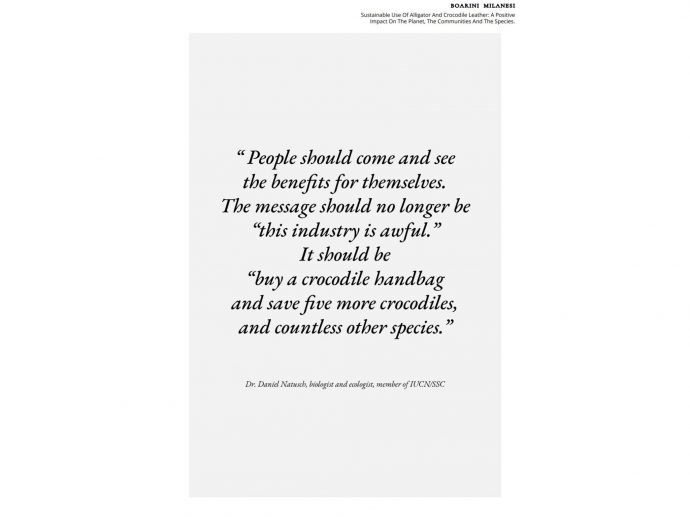Categories more
- Adventures (17)
- Arts / Collectables (15)
- Automotive (37)
- Aviation (11)
- Bath, Body, & Health (77)
- Children (6)
- Cigars / Spirits (32)
- Cuisine (16)
- Design/Architecture (22)
- Electronics (13)
- Entertainment (4)
- Event Planning (5)
- Fashion (46)
- Finance (9)
- Gifts / Misc (6)
- Home Decor (45)
- Jewelry (41)
- Pets (3)
- Philanthropy (1)
- Real Estate (16)
- Services (23)
- Sports / Golf (14)
- Vacation / Travel (60)
- Watches / Pens (15)
- Wines / Vines (24)
- Yachting / Boating (17)
Published
02/19/2021 by Boarini MilanesiThe report drawn up by the luxury bag brand Boarini Milanesi begins with a quote from Dr Daniel Natusch, biologist and member of the International Union for the Conservation of Nature: "Buy a crocodile bag and you save five more". The report uses three scientific reasons to demonstrate that alligator and crocodile bags are good for the planet, communities and the animals themselves.
The report was published in response to the accusations of hypocrisy against Boarini Milanesi following the launch of the most expensive bag in the world, worth 6 million euros, made of precious stones and alligator leather and created to raise awareness on the pollution of the seas.
The report was compiled using the research of numerous scientists and species conservation experts belonging to the IUCN, an organisation which includes over 17,000 scientists and more than 1,400 member organisations, including the WWF, Global Nature Fund, Wildlife Conservation Society (WCS) and CNR.
The report reaches the following conclusions:
1. The use of alligator and crocodile leathers contributes to the preservation of the species
Crocodiles and alligators are seen by the communities living in close contact with them as dangerous for their personal safety and that of their farms. The sustainable use of these animals allows people to tolerate them, because they are useful for their economic sustenance. Based on these considerations, programs for the sustainable use of crocodiles and alligators have been implemented which have led to an increase in current population numbers. From 1960 to date in Louisiana, the alligator population has gone from being in danger of extinction to reaching numbers around 3-4 million in the wild. In countries such as Sri Lanka, where no plans are in place for the sustainable use of the species, the Porosus crocodile is considered severely depleted, with known destruction of its eggs and habitat.
2. The use of alligator and crocodile leathers contributes to the health of the planet
Wetlands - the natural habitat of crocodiles and alligators - are the ecosystem with the best capacity to store carbon (in some cases capable of storing twice as much as forests) and can reduce the damage caused by tsunamis and floods. However, they are destroyed every day to create agricultural land or tourist settlements (some studies calculate that 87% of them have been lost since 1700). Sustainable crocodile use programs incentivise populations to keep their wetlands intact and recreate them where they have been destroyed.
3. The use of alligator and crocodile leathers helps local communities
Programs for the sustainable use of crocodiles and alligators generate revenues that improve the quality of life of the poorest communities (from the schooling of children to the construction of drinking water plants and hospitals) and also bring money into the public coffers of more developed countries.
In Louisiana, taxes on the unique wild alligator tracking tag (one of the required taxes for “croc industry” operators) brought 1.9 million dollars into the state's coffers in 2018 alone.
Carolina Boarini, co-founder and CEO of Boarini Milanesi, said,"For Boarini Milanesi, these three points are the start of an information campaign aimed at breaking down the fake news that influences public opinion, putting this delicate safeguarding work at risk".
"We do not agree with the choice of some luxury brands to abandon the use of exotic leathers", declared Matteo Rodolfo Milanesi, co-founder and CEO of Boarini Milanesi. He continued, “For us, stopping their use would simply be a marketing move to capture an audience that ignores reality. A serious mistake that would jeopardize the conservation of these species and the well-being of entire communities".















